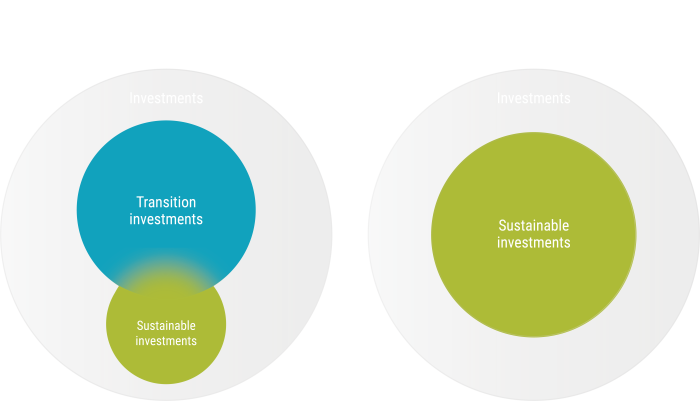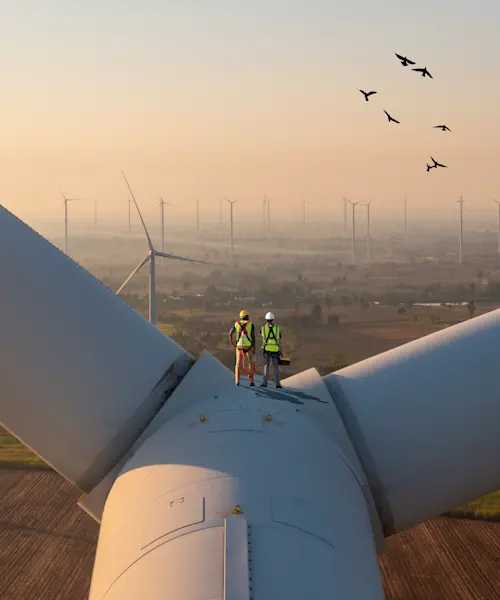Sustainable transition at Robeco
Navigating sustainable transition
Let us guide you through the complexities of investing in the sustainable transition, uncovering opportunities to generate alpha. Explore the urgency, significance, and playing fields of this transformative journey.

Defining transition investing
There are multiple definitions of transition investing. Our definition closely aligns with those set forth by the EU Commission, the UK's Sustainable Disclosure Regulation and the Singapore-Asia Taxonomy for Sustainable Finance:
Investing in strategies that focus on preparing for, being aligned to, benefitting from, and/or contributing to the transition to a low-carbon economy.
What is the difference with sustainable investing?
There is a subtle difference between ‘transition investing’, which focuses on companies trying to be more sustainable, and pure-play ‘sustainable investing’, which primarily looks for companies which are already there. Finding these transitioning companies – rather than fixating on already transitioned companies – is a growth area that could reap higher returns in the future.

The urgency of sustainable transition
Transition has never been more vital. Future temperature rises threaten ever-more catastrophic climate change, while neither our global population nor its consumption rates are abating. Therefore, simply selling heavy emitters and buying lower emitters to align with the Paris-aligned decarbonization target does not guarantee a direct decline in real-world emissions. For this to happen, we need heavy emitters to carry their weight and lower their emissions – or in other words to ‘transition’.
Winning by not losing
Since the Industrial Revolution, failure to keep up with current trends has often jeopardized business survival. Just look at those who missed out on – and those who benefited greatly from – moving from horsepower to machinery.
We believe that there will come a time when companies (or countries) that do not transition will go the same way as the horse owners.
How we can generate alpha
To navigate the transition investment landscape, alpha generation comes from understanding the direction of travel and identifying the winners and losers in this dynamic process. There is a broad universe to assess, as transition investing targets companies who may be at the beginning of their decarbonization journeys. Regulation is currently driving transition momentum, however this journey is set to last several decades.
Any company currently preparing for a low-carbon future will have a significant advantage over those that are not. Our investment process recognizes the multiple dimensions of transition to create robust and resilient investment solutions that understand both the complexity and the longevity of this transition – all with our eyes on the prize of generating alpha.
Transition is about the future and the ability to navigate changing (regulatory) environments. Both public and private markets are needed to make this happen. Choosing the right investments requires us to develop clear frameworks that embrace the dynamic and multi dimension of transition.
Making it investible
The challenge for professional investors lies in translating transition concepts into investable portfolio assets. This requires a hard look at who qualifies, and on what grounds. As always, getting hold of the right research is crucial to find the transition champions.
How companies are deploying and utilizing their capital expenditures to finance a more sustainable future is key. Robeco has decades of experience in understanding just that and making the right investment calls.
It’s essential to acquire as much forward-looking data as possible. Emissions data is a good way to track progress, but it is backward-looking. Our SI teams have developed research frameworks that look at future patterns rather than past. Plotting future moves is a new frontier for most asset managers, but Robeco has decades of experience with developing and reforming its sustainable investing practices.
Global opportunity, Asia sets the pace
Sustainable transition presents a worldwide opportunity, yet the forefront of combating climate change predominantly lies within Asia. Asia accounts for half of the world’s greenhouse gas emissions and is home to about 60% of the global population. Despite the acute need for Asia’s transition, flows toward these investments have been hampered by limited applicable standards that consider the region’s diverse geographical and economic challenges.
That’s why our emerging markets teams specifically look at Asia, and from a ringside seat from Robeco’s offices in Hong Kong, Shanghai and Singapore. Our local expertise can identify solutions, such as using corporate bonds and green bonds to direct capital to the right places. This doesn’t mean the rest of the world can rest on its laurels. Globally, all companies need to adopt their own business ecosystems to find their pathway toward climate‐resilient development.
The main transition areas
The Industrials sector is at the forefront as it consumes high amounts of energy and makes many unsustainable products, followed by Energy itself, and then Materials. The Information Technology, Financials and Health Care industries are already fairly sustainable, not including their energy consumption. But others are rather complex, such as changing the global agricultural system and ultimately moving to a more circular economy.

Electricity

Industrial processes

Food and agriculture

Transport
